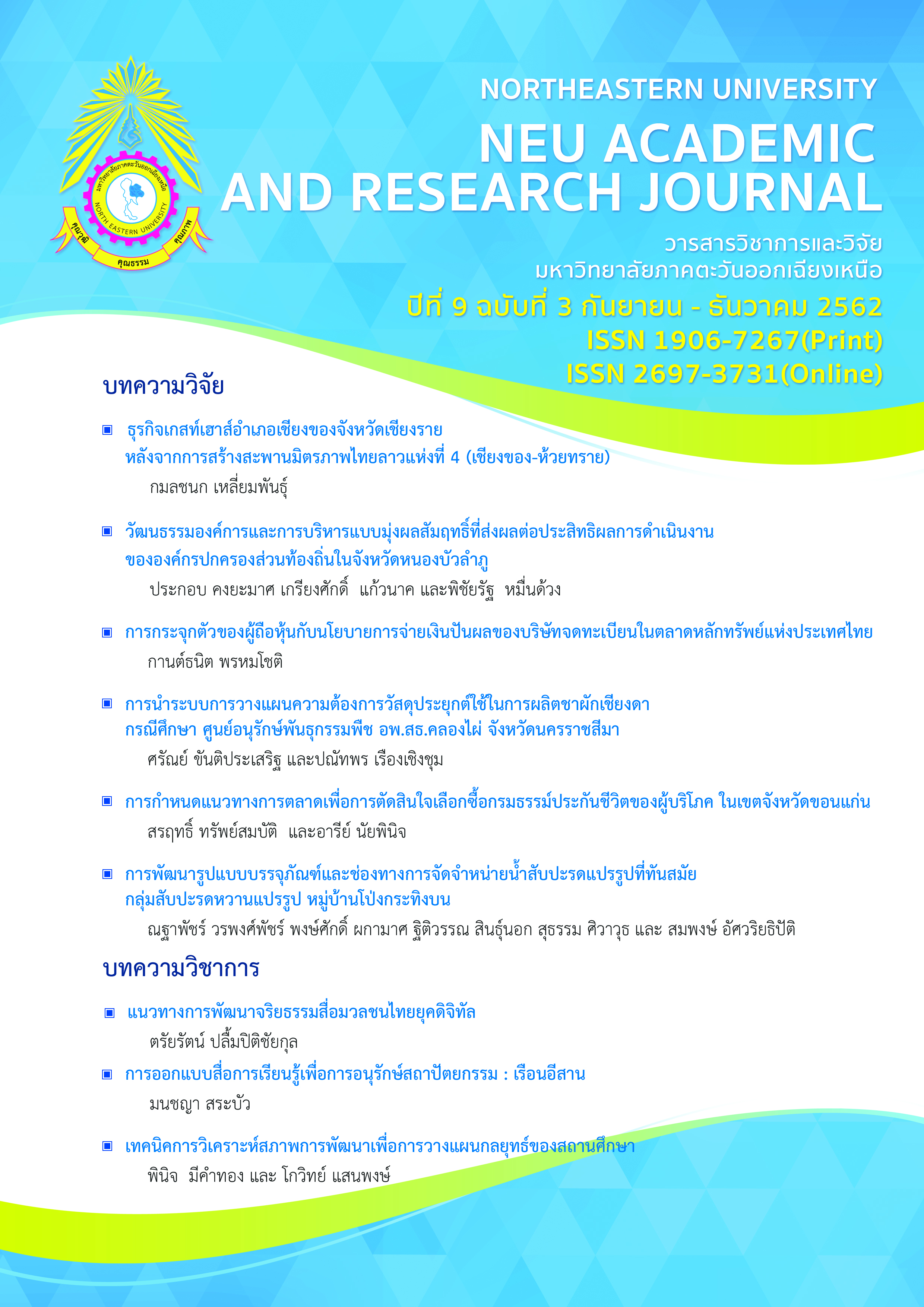Concentration of shareholders and dividend policy of listed companies in the Stock Exchange of Thailand
Keywords:
Concentration of Shareholders, Dividend Payment Policy, The Stock Exchange of ThailandAbstract
The purpose of this study is to study the relationship between the concentration of shareholders and the dividend policy of listed companies in the Stock Exchange of Thailand. The population used in this research is Companies listed on the Stock Exchange of Thailand for the year 2016 with a total of 531 companies (including companies in the Market Alternative Investment (Mai and Mutual Fund) and statistics using descriptive statistics to Describe the characteristics of the sample studied Analysis of econometric methods, creating a multiple regression model and using ML - Binary Logit (Quadratic hill climbing) techniques for estimating parameters and statistics by Eviews program The study indicated that Independent variables have a relationship to explain the variation of the dividend rate of listed companies in the Stock Exchange of Thailand to 39.24 percent and have a constant Y-axis equal to -8.289661. The factors that determine the dividend payment of listed companies in the Stock Exchange of Thailand are the shareholding of the top 5 major shareholders. Return on assets Business size Debt to asset ratio Shareholding ratio of directors and executives And the ratio of retained earnings per capital is a factor that affects the rate of dividend payment with statistically significant significance at 0.05
References
ตลาดหลักทรัพย์แห่งประเทศไทย. (2555). หลักการกำกับดูแลกิจการที่ดีสำหรับบริษัทจดทะเบียนปี 2555. สืบค้นเมื่อ 15 มิถุนายน 2562. จาก https://www.set.or.th/sustainable_dev/th/cg/files/2013/CGPrinciple2012Thai-Eng.pdf.
นันทิชา ชลวณิชย์กุล. (2556). ผลกระทบของโครงสร้างผู้ถือหุ้นต่อนโยบายเงินปันผลของบริษัทในประเทศไทย. (การศึกษาค้นคว้าอิสระวิทยาศาสตรมหาบัณฑิต, มหาวิทยาลัยธรรมศาสตร์).
รณชัย ชูประสูตร. (2556). ผลกระทบของผู้ถือหุ้นสถาบันต่อโครงสร้างเงินทุน นโยบายเงินปันผลจ่าย และการถือหุ้นของผู้บริหารและกรรมการบริษัท. (การศึกษาค้นคว้าอิสระวิทยาศาสตรมหาบัณฑิต, มหาวิทยาลัยธรรมศาสตร์).
รัญชิดา กุฎีศรี. (2559). ผลกระทบของบริษัทที่มีโครงสร้างการถือหุ้นแบบครอบครัวต่อการกำกับดูแลกิจการที่ดีในกลุ่มตลาดหลักทรัพย์แห่งประเทศไทย. ใน การประชุมวิชาการระดับชาติราชภัฏเพชรบุรี วิจัยเพื่อแผ่นดินที่ยั่งยืนครั้งที่ 6 (หน้าที่ 1-7). สืบค้นจาก https://www.journal.pbru.ac.th.
เริงรัก จำปาเงิน. (2544). การจัดการการเงิน (พิมพ์ครั้งที่ 2). กรุงเทพฯ: บุคเน็ท.
วัชรพล บูระชาติ. (2553). การศึกษาอัตราผลตอบแทน ความเสี่ยง และผลการดำเนินงานของหลักทรัพย์ในตลาดหลักทรัพย์ MAI ปี พ.ศ. 2550-2552. (วิทยานิพนธ์เศรษฐศาสตรมหาบัณฑิต, มหาวิทยาลัยธรรมศาสตร์).
สุทธิพงษ์ รินวิไลรักษ์. (2547). ศึกษาปัจจัยที่มีผลต่อการจ่ายเงินปันผลและเปรียบเทียบผลประกอบการของกลุ่มบริษัทที่ดำเนินนโยบายปัญหาที่เกิดจากตัวแทนที่ต่างกัน. (วิทยานิพนธ์บริหารธุรกิจมหาบัณฑิต, มหาวิทยาลัยหอการค้าไทย).
Chay, J. B., & Suh, J. (2009). Payout policy and cash-flow uncertainty. Journal of Financial Economics, 93(1), 88-107.
Jensen, M. C. (1986). Agency costs of free cash flow, corporate finance, and takeovers. American Economic Review, 76, 323-329.
Menard, S. (1995). Applied logistic regression analysis. Thousand Oaks, CA: Sage.
Ramli, N. M. (2010). Ownership structure and dividend policy: Evidence from Malaysian companies. International Review of Business Research Papers, 6(1), 170-180.
Rizqia, D. A., & Sumiati, S. A. (2013). Effect of managerial ownership, financial leverage, profitability, firm size, and investment opportunity on dividend policy and firm value. Journal of Finance and Accounting, 4(11), 120-130.
Wang, D. (1999). Founding family ownership and earnings quality. Journal of Accounting Research, 44(3), 619-656.



